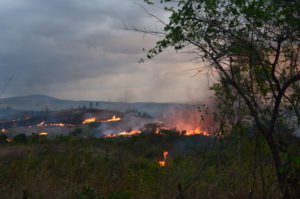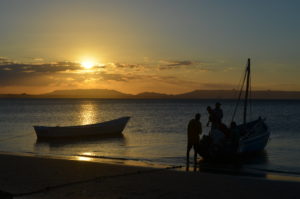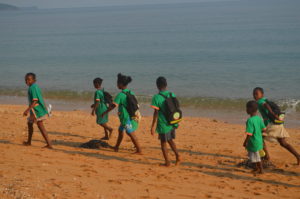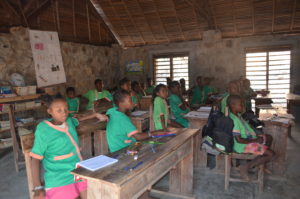10 November 2016
Madagascar Today (Part 2)
A fascinating and tragic country.
by Lynda Goetz
 “Madagascar has become the world’s poorest country,” asserted the guide with whom I stood watching the out-of-control fire approach closer and closer to our very basic lodge on the edge of the Ankarana Special Reserve. “It shouldn’t be, because it is rich in resources, but the Malagasy people do not benefit from those resources.” Depending on whose data, chart or statistics you refer to, Madagascar comes in as either the 10th, 9th,6th or 5th poorest country in the world, with an average per capita income of between $463 and $1,447.78, again depending on whose statistics you are relying upon. However, like many statistics, even these figures are misleading, as masses of the country’s rural poor barely get to use currency at all and are mainly living off the land and natural resources around them. Of course, this information will hardly come as a surprise to anyone who has visited any one or more of the dozens of poor countries in Africa. The tragedy of Madagascar is that it is not actually making progress towards economic security, but is going backwards in terms of prosperity and backwards also in terms of conservation.
“Madagascar has become the world’s poorest country,” asserted the guide with whom I stood watching the out-of-control fire approach closer and closer to our very basic lodge on the edge of the Ankarana Special Reserve. “It shouldn’t be, because it is rich in resources, but the Malagasy people do not benefit from those resources.” Depending on whose data, chart or statistics you refer to, Madagascar comes in as either the 10th, 9th,6th or 5th poorest country in the world, with an average per capita income of between $463 and $1,447.78, again depending on whose statistics you are relying upon. However, like many statistics, even these figures are misleading, as masses of the country’s rural poor barely get to use currency at all and are mainly living off the land and natural resources around them. Of course, this information will hardly come as a surprise to anyone who has visited any one or more of the dozens of poor countries in Africa. The tragedy of Madagascar is that it is not actually making progress towards economic security, but is going backwards in terms of prosperity and backwards also in terms of conservation.
A trip to any part of Madagascar will almost inevitably involve wildlife; the biodiversity is incredible. Whether you are interested in mammals, birds, reptiles, insects or plants, Madagascar, like the Galapagos, shelters a diversity of species, many of which are found nowhere else on the planet. Lemurs, of which there are 60 different varieties in the country, are cuddly and appealing. Almost all are now regarded as endangered, from habitat extinction (deforestation) and, shockingly, hunting. Traps have even been found in the Ankarana Reserve, a patrolled and supposedly protected reserve. The lemurs’ evolution and lack of natural predators make them less fearful than they should be and thus easy prey to hungry locals, perhaps not bound by traditions protecting them, and even to the international pet trade (although keeping lemurs as pets has been outlawed since 1964).
Part of the problem for both the people and the wildlife of Madagascar is the massive increase in population over the last 50 to 60 years. Although population figures for the country are not very reliable, as the last accurate census occurred in 1993, most estimates put the population increase over this time years as about 300%, from 5.6 million when the colonial era ended, to the roughly 24 million it is ‘guesstimated’ to be today. Given that the percentage of the population under 24 is around 60%, this increase is not about to slow down any time soon, and the pressures on the limited useable land available are intense. The fact that, because of its long isolation and unique geology, the country is home to literally hundreds of endemic species of fauna and flora is probably of little interest to a population where one in three cannot read and write and the struggle is to keep your family fed, not worry whether yet another endemic species might become extinct. Both concerns are very real.
The fire which came to within a few hundred metres of our lodge and caused a certain amount of anxiety to local inhabitants as well as visitors is not an unusual event, particularly at this time of year, just before the rains. The practice, known as tavy, may have been criminalised, but as there is no real political will to enforce, nor the manpower to do so, it continues apace. It is an agricultural practice brought to the country by the early settlers and practised with enthusiasm ever since for its practical benefits and its cultural associations with prosperity, health and venerated ancestral custom. The land is needed for cash crops (coffee, ylang-ylang, cocoa and vanilla and other spices), for subsistence farming and for the grazing of the ubiquitous zebu, the hump-backed Asian cattle (Bos Taurus inidicus) brought to Madagascar by the early settlers and which, according to some sources, actually outnumbered the human population at one point earlier this century, when there were some 19 million of the animals in the country. These animals represent not only status (they are frequently used as dowry) but a source of income. They’re used to draw all types of carts and are important as sacrificial animals. Their hides are also used and jewellery is made out of their horns. Small wonder then that their need for grazing overrides environmental considerations. In addition to the agricultural needs of the rural population, deforestation is not helped by the continuing reliance on charcoal as a fuel for cooking.
In addition to all this, the political coup in 2009 has also been a disaster as far as the environmentalists are concerned. Whereas the previous government had banned the state-sanctioned harvesting of precious hardwoods within the national parks from 2000 onwards, the present government has once again allowed this as a key source of state revenues to offset cuts in donor support. The subsequent heads of state do not appear to have the same concern as did their predecessor with regard to deforestation and it is anticipated that at the present rate all the island’s rainforests, excluding those in protected areas and the steepest eastern mountain slopes, will have been deforested by 2025.
 The rainforest which we visited was the northern national park of Montagne d’Ambre (Amber Mountain), the first national park created in the country in 1958. This is an isolated patch of montane rainforest which rises out of the surrounding dry area. It covers around 185 square kilometres and is home, inter alia, to eight different kinds of lemur and eleven different kinds of chameleon, including brookesia minima (believed to be the smallest chameleon until 2012, when brookesia micra was found on the islet of Nosey Hara). Although this park is the only one in the whole of Madagascar where you are not obliged to be accompanied by an official guide, the benefits of having one are immeasurable. Not only did our guide spot several chameleons and other reptiles we would never have seen by ourselves, (including brookesia minima and the mossy leaf-tailed gecko), but the information we gleaned on all the wildlife, including insects and birds, was far more than we would ever have gathered by ourselves. Interestingly, he recounted acting as guide last year to a German entomologist and his colleague, who apparently found twice as many endemic species during their two week scientific study in the forest as were recorded as existing there.
The rainforest which we visited was the northern national park of Montagne d’Ambre (Amber Mountain), the first national park created in the country in 1958. This is an isolated patch of montane rainforest which rises out of the surrounding dry area. It covers around 185 square kilometres and is home, inter alia, to eight different kinds of lemur and eleven different kinds of chameleon, including brookesia minima (believed to be the smallest chameleon until 2012, when brookesia micra was found on the islet of Nosey Hara). Although this park is the only one in the whole of Madagascar where you are not obliged to be accompanied by an official guide, the benefits of having one are immeasurable. Not only did our guide spot several chameleons and other reptiles we would never have seen by ourselves, (including brookesia minima and the mossy leaf-tailed gecko), but the information we gleaned on all the wildlife, including insects and birds, was far more than we would ever have gathered by ourselves. Interestingly, he recounted acting as guide last year to a German entomologist and his colleague, who apparently found twice as many endemic species during their two week scientific study in the forest as were recorded as existing there.
Whilst many people may not be interested in new species of rare insects or the fact that scores of different dragonflies live in Madagascar and nowhere else, it is this extraordinary feature of Madagascar which has led some to describe this island as the ‘eighth continent’. However, 2025 is not very far off and the poverty-stricken population is increasing rapidly. The present government continues to allow the logging and export (mainly to China) of scarce species of rosewood and ebony from protected forests and does  nothing to prevent the practice of tavy. Illegal logging, driven by the desperate poverty and government corruption, unfortunately as endemic as much of the wildlife, add to the problem.
nothing to prevent the practice of tavy. Illegal logging, driven by the desperate poverty and government corruption, unfortunately as endemic as much of the wildlife, add to the problem.
The government and an increasing number of investors see mining as a future wealth generator for Madagascar, or possibly more likely for a small number of vested interests. However, in 2015 the revival of the ailing industry was hampered, like so much else, by the political instability; and although there is vast potential, the fear is that more environmental damage will be caused with little to show for it terms of increased prosperity for the country as a whole. Already there are serious grievances around the Rio Tinto venture in southern Madagascar near Fort Dauphin, with local protests against the company (80% owned by Rio Tinto and 20% by the Madagascan Government), whose exploitation of its rights has affected both agriculture and fishing. Precious and semi-precious stones are also to be found in Madagascar, but again the exploitation of these seems not to be filtering back to the local economy. Even the profits from the world-renowned vanilla crop (which we learnt has to be hand-pollinated) appear now to be benefiting foreign investors more than local growers and workers.
Once again, this can be traced back directly to political instability and the government. The coups in 2002 and 2009 led to a suspension of aid from the US and the EU. China stepped into the breach to become the new government’s political and economic ally. By 2011 the government was offering large tax breaks to Chinese companies exporting Malagasy vanilla, but although overall export volumes rose, prices were pushed down by the Chinese using their dominant position in the market. Another distressing side-effect for local growers and workers is the new legislation which fixes a specific date for the harvest – so that instead of harvesting green vanilla pods throughout the growing season from May to January growers are now forced to pick everything they have over one week.
 It is hard to see how Madagascar can get out of this cycle of dependency and reliance on aid. One thing is certain; the education of the 40% of the population under 15 is crucial and in this too the government is failing dismally. Help from small foreign charities is doing massive good in some places and we were able to witness this at first hand in the village of Anjanojano where the Association Docenda, a French charity set up by a husband and wife team, have, with a group of associates and collaborators, completed a school for the local children from 3-15. (http://www.docenda.fr/pages/une-ecole-primaire-a-anjanojano.html) To see these children cheerfully making their way along the beach between the village and the school 4 times a day is inspirational. Perhaps, as some have suggested, eco-tourism is a way forward, a way of helping both the people and of preserving Madagascar’s unique wildlife for both these and our own children.
It is hard to see how Madagascar can get out of this cycle of dependency and reliance on aid. One thing is certain; the education of the 40% of the population under 15 is crucial and in this too the government is failing dismally. Help from small foreign charities is doing massive good in some places and we were able to witness this at first hand in the village of Anjanojano where the Association Docenda, a French charity set up by a husband and wife team, have, with a group of associates and collaborators, completed a school for the local children from 3-15. (http://www.docenda.fr/pages/une-ecole-primaire-a-anjanojano.html) To see these children cheerfully making their way along the beach between the village and the school 4 times a day is inspirational. Perhaps, as some have suggested, eco-tourism is a way forward, a way of helping both the people and of preserving Madagascar’s unique wildlife for both these and our own children.
If you enjoyed this article please share it using the buttons above.
Please click here if you would like a weekly email on publication of the ShawSheet

